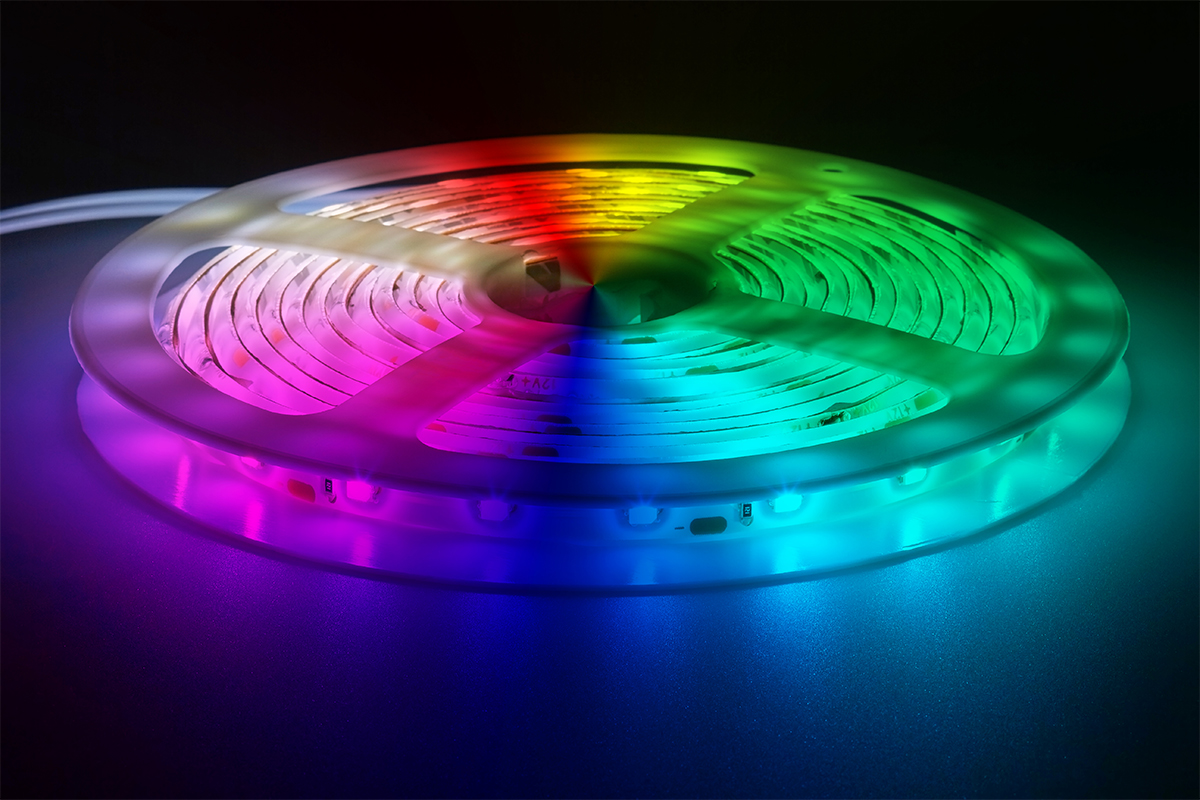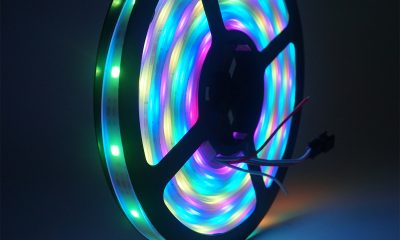What is an RGB LED strip light
An RGB LED strip light is a linear assembly of multi-color RGB LED packages on a flexible printed circuit board that usually comes with an adhesive backing. Although an RGB color mixing system can be implemented using separate LED packages, most RGB LED strips use integrated LEDs which incorporate red, green, and blue diodes into a single package. Integrated RGB packages exhibit good color mixing in both the near and the far field, whereas products that use individually packaged LEDs does not exhibit good color mixing in the near field. At a very close range to the light strip, the beams from the LEDs will be separate and different colors are clearly visible.
Color gamut
Mixing of the three primary colors of visible light (red, green, and blue) allows to create secondary colors within the limits of the gamut. RGB mixing with direct emission narrow-band LEDs, however, cannot produce high quality whites and extremely saturated color at any hue except red, green and blue in part due to the narrow full width at half maximum (FWHM) values of the green and red LEDs. Additional colors are therefore often added to produce an enhanced spectrum of light. The inclusion of a white LED enables RGBW LEDs to produce white light with improved efficacy and color rendition and to create saturated reds and a full range of pastels. The addition of an amber LED expands the gamut to include warmer tones such as rich gold, yellow, and orange shades.
Chip technology
To produce predictable colors from RGB or RGBW LED strips, accurate dimming control of all the component LEDs (red, green, blue, and other additional colors) is critical. Blue and green LEDs are fabricated using indium gallium nitride (InGaN) chip technology. InGaN LEDs do not follow a perfectly linear relationship between forward current and luminous intensity. An increasing forward current may be accompanied with a reduction in the dominant wavelength of blue and green LEDs. On the other hand, red LEDs which are currently based on aluminum indium gallium phosphide (AlInGaP) materials hardly suffer any color shift as a function of current. However, AlInGaP-based red LEDs have poor quantum efficiencies and the thermal efficiency droop associated with these LEDs is much greater than that associated with InGaN-based blue and green LEDs. The variations in the performance characteristics of red, blue and green LEDs at various current densities create a need for a control system to maintain a consistent color point.
LED dimming
There are two dimming mechanisms employed in adjusting the light output of LEDs: pulse-width modulation (PWM) and constant current reduction (CCR). As there’s an efficiency droop associated with blue and green LEDs when they’re operated at higher current density, dimming with CCR which involves adjusting the current to the LED often fails to achieve accurate color and brightness. PWM dimming adjusts the intensity of the light output by varying the duty cycle of a constant current supplied to the LED. Because the human eye can integrate or average the pulses of emitted light, the perceived brightness of an LED under pulse-width modulation is basically proportional to the duty cycle of the pulsed LED current. Since the LEDs are always powered at their rated current, the color point of LED emission is maintained regardless of dimming level. This is advantageous for RGB color mixing applications that require a consistent chromaticity over a wide range of dimming levels. PWM dimming allows control of the individual brightness of each LED (red, green, blue and white) in PWM steps of 1/256 over the full range from 100% to 0% without color shift. CCR dimming allows only 10-to-1 dimming ratios and can induce a color shift when LEDs are driven below their rated current.
Analog control vs. digital control
When it comes to lighting control there are two types of RGB/RGBW LED strips: “analog” and “digital”. Analog control only allows the RGB/RGBW LED strip to display one color across the entire run of the strip at a time. RGB/RGBW LED strips with digital control ability can produce different colors at different intensities on multiple LEDs simultaneously. This level of control is accomplished by using addressable LEDs which can individually be commanded and controlled. An addressable LED is a digitally controllable LED that integrates a control circuit and LED chips into a single SMD package. The LED package comes typically with a 5mm x 5mm (5050) physical footprint. The control IC can individually drive each LED within the package and pass control data over the LEDs of a strip through Serial Peripheral Interface (SPI) protocol. A control IC integrated in an RGB/RGBW LED may contain serial shift registers, data latches, output registers, band gap reference voltage generator, internal oscillator, and programmable constant output current drivers. Control ICs currently available on the market include, but not limited to, WS2801, WS2803, WS2811, WS2812, APA102C, SK9822, LPD6803, LPD1101, D705, UCS6909, UCS6912, LPD8803, LPD8806, TM1803, TM1804, TM1809, TM1812, UCS1903, UCS1909, UCS1912, TLS3001, TLS3002, P9813, 74CH595, MB5026, DM134, DM135, and ZQ9712.
RGB controller
All RGB LED strips require a controller to mix the light emitted from the multi-color LEDs into a desired color. An RGB controller may be used to program customizations with regard to brightness, color, and color-changing mode. Non-addressable LED strips require the controller to provide external PWM dimming control. Addressable LED strips do dimming internally and typically work with an SPI LED controller. An SPI LED controller is a SD card based controller which allows you to switch between different animations when it is operated as a standalone SD card digital animation player. You can also use SPI LED controller over DMX for very sophisticated programming. You can connect the LED strip to a microcontroller or microprocessor, such as Arduino, Raspberry Pi, BeagleBone, Propeller, and SparkCore. These microcontroller or microprocessors provide an interface between the computer and the LED strips, allowing you to use computer software to generate content for your SD card.


















Loading...